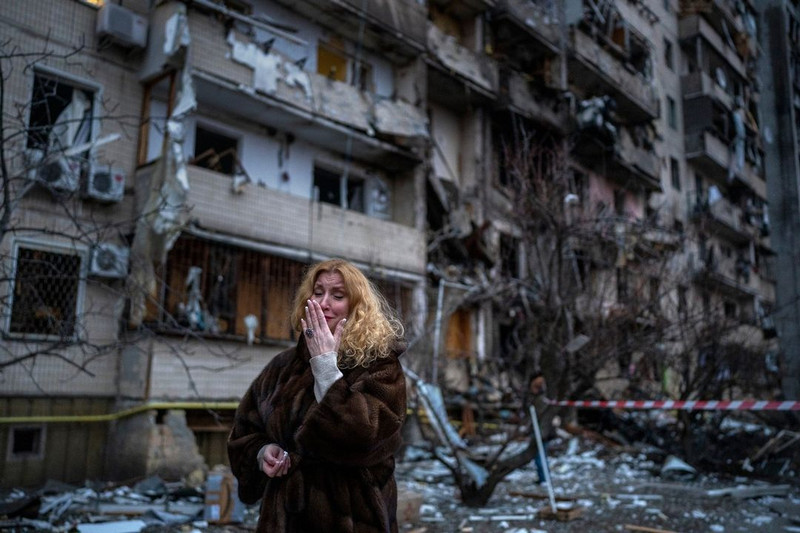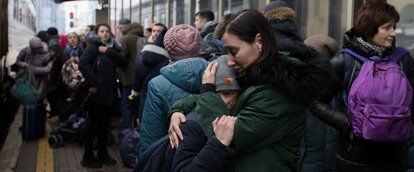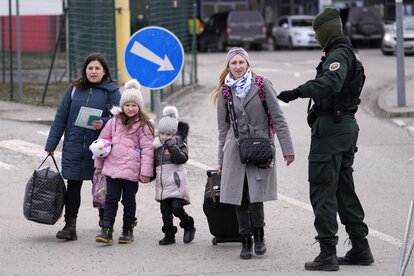WAR IN EUROPE
Being Women in a country under attack

Gender Dimension of the war in Ukraine in a nutshell
One year has passed since the armed attack by Russia against Ukraine and the ensuing hostilities have brought the most severe forms of human rights and international humanitarian law violations into the everyday lives of people in Ukraine, putting at risk countless lives, and causing massive displacement and destruction of civilian infrastructure.
Up to date (13 February 2023), OHCHR has recorded more than 7,199 killed (2,888 men, 1,941 women, 226 boys, and 180 girls, as well as 32 children and 1,932 adults whose sex yet to be known) civilians and more than 11,756 injured since 24 February 2022. The actual figures are unfortunately considerably higher.
Another crucial element after the attack, was the huge wave of refugees, that left the country and the internal displacement. As of December 2022, an estimated 7,8 million Ukrainians have fled to other parts of Europe. An additional 5.6 million Ukrainians are recorded as internally displaced, while 3,7 million are living under threat or difficult circumstances with no access to basic services.
Being Women in a country under attack
At the same time, life needs to go on, but not “as usual”. Women in Ukraine continue to give birth, take care of their families, and work, in many cases without their partners, fathers, or brothers since they have to defend the country in the field.
When the war started, 265,000 were pregnant. Since the beginning of the full-scale Russian invasion, European Union declares that more than 102,000 babies have been born in Ukraine. Nevertheless, how was that possible and in what conditions? Women gave birth in basements, bomb shelters, and hospitals under attack. That was and still is the reality for many pregnant women in Ukraine.
At the same time, women continue to support the economy through their work in agriculture, manufacturing, information technology, the service sector, and businesses. Needless to say, that some of them registered to the military and defend freedom and democracy in the frontline.
Yet, many women are left to care for their families on their own, including by being responsible for earning an income for their household. This can be due to their partners being unemployed, conscripted, or deceased or due to family separation.
Since the beginning of the war, the extent of unpaid work, meaning the caring of households, children and elderly people, for both men and women has increased as social services, medical, education, and childcare facilities are disrupted by the war. Unpaid work now includes care work, domestic work, and volunteering. Lack of access to social services including schools and strained community resources have increased the care burden of local women who are responsible for the care of children, disabled, and elderly family members.
Another element that women in Ukraine have to deal with is food insecurity. Especially women in rural areas in the territories occupied by the Russian military. The situation differs in accordance with their geographical position in the country, their social status, and the fact that they may be internally displaced.

Gender-Based Violence in Wartime
Arguably, hundreds of women and girls in Ukraine have become victims of sexual assault and torture committed by the Russian army and reports have documented the increasing use of rape as a weapon of war. Conflict-related sexual violence is one of the biggest problems in the territories that are occupied or in places which active hostilities are taking place or where the military is present.
The Independent International Commission of Inquiry report on Ukraine refers to findings about incidents taking place during late February and March 2022 in the four provinces of Kyiv, Chernihiv, Kharkiv, and Sumy, as requested by the Human Rights Council in its resolution S-34/1.
The Commission documented patterns of summary executions, unlawful confinement, torture, ill-treatment, rape, and other sexual violence committed in areas occupied by Russian armed forces across the four provinces on which it focused. People have been detained, some have been unlawfully deported to the Russian Federation, and many are still reported missing. Sexual violence has affected victims of all ages. Victims, including children, were sometimes forced to witness the crimes.
Historically, research has documented many cases of conflict, such as the Bosnian War, where rape has been used as a weapon of war. Wars and civil conflicts can create a "culture of violence" or a "culture of impunity" towards human rights abuses of civilians. During periods of armed conflict, there are structures, actors, and processes at a number of levels that affect the likelihood of violence against civilians. Sexual violence is one of many types of violence directed against civilians in wartime situations. These violations continue to have a devastating effect on victims and survivors. Significantly, victims emphasized the essential role of justice and accountability.
Moreover, in the Ukrainian case, the Commission investigated cases of rape committed by some soldiers of the Russian armed forces during the period under review in localities that came under their control, which are war crimes. Victims ranged from 4 to over 80 years old. Perpetrators raped the women and girls in their homes or took them and raped them in unoccupied dwellings. In most cases, these acts also amount to torture and cruel or inhumane treatment for the victims and for relatives who were forced to watch.
The investigation is still ongoing; to identify to what extent the sexual and gender-based violence constituted a widespread pattern.
Women who fled the country
Of 7,8 million Ukrainians who have fled to other parts of Europe, it is estimated that 90 percent are women and children. In many cases, displaced women and children have to rely on informal and unvented sources of shelter, which poses a potential security risk.
Especially, women who have fled to Poland struggle to access abortions. Many Ukrainian women who were driven out of their homes by the war have found themselves in neighbouring Poland, where abortion is severely limited. Even helping someone access an abortion can result in a lengthy jail sentence. NGOs in Poland, who attempt to help Ukrainian women, testify that in many cases women are denied to be regarded as victims of rape, and during interviews with the police and prosecutors they could be retraumatized.
Lastly, as most men are prohibited from leaving Ukraine, many women refugees also bear multiple burdens as caretakers of children and the elderly.

Conclusion
Despite the critical role women are playing in Ukraine, the perspective of women has not been given the needed attention from the dominant narratives about the war. Additional focus should be given to the vital need for women’s involvement in potential peace, national reconstruction, and reconciliation.
Many would argue that in periods of conflict and war, there are no rules, no laws and it is “us” against “them”. This was the logic during the previous wars that left scars not only on the generations under the war but also on the generations to come.
In contrast to that argument, I would highlight that the faults of the past, helped leaders to draft legislations, create international bodies and organizations and promote the norms and ideas, which are universally accepted today.
Attacking inhabited cities and villages, cold-blood killing, and torturing civilians is clearly a plan of a greater Russian strategy. For that reason, not only is there an urgent need for the war to end but also for international bodies to research all crimes committed. Only if justice has been rendered, should we consider peacebuilding processes and stability in the region after the war.
Sources:
https://www.ohchr.org/en/news/2023/02/ukraine-civilian-casualty-update-13-february-2023
https://www.eeas.europa.eu/eeas/ukraine-giving-birth-during-war_en
https://www.ohchr.org/en/statements/2023/01/ukraine-briefing-security-council-asg-ilze-brand-kehris
https://www.ohchr.org/en/statements-and-speeches/2022/12/human-rights-situation-ukraine
https://www.unwomen.org/en/digital-library/publications/2022/05/rapid-gender-analysis-of-ukraine
https://www.fao.org/3/cc1025en/cc1025en.pdf
https://www.npr.org/2022/06/01/1101473557/ukrainian-refugees-abortions-europe-poland-warsaw
